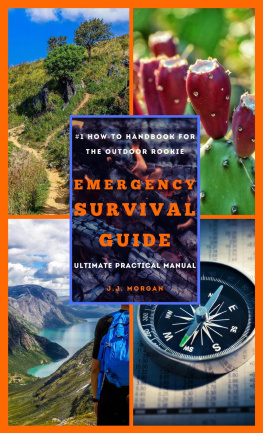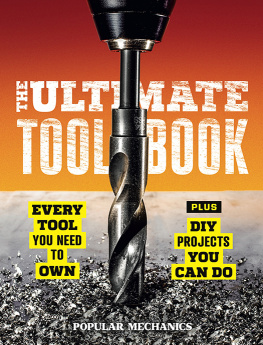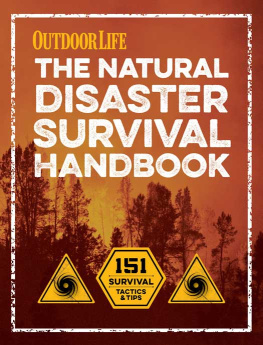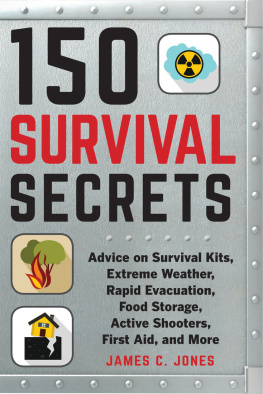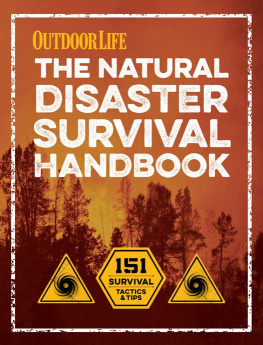LETTER FROM THE EDITOR
How to Survive
WHEN I WAS in fourth grade, my teacher suggested a book to read over the summer: My Side of the Mountain, the classic novel by Jean Craighead George about a teenage boy who runs away and ends up living in a hollowed-out tree and training a hawk. I never ran away from home, but I always wondered if I could have survived the way the boy in the book does.
Recently my wife and I read the book and showed the 1969 film version to our two boys. We asked them if they thought they could make it out in the wildone said yes, the other wasnt so sure.
Survival means different things to different people in different situations. Throughout its existence, which spans 115 years and counting, Popular Mechanics has regularly published stories about all kinds of survival: in the woods alone; stuck in a mountain crag with no water; marooned on an iceberg as polar bears approach; trapped in a car by a fallen tree. Survival can mean simple self-sufficiencyliving off the land, relying on only oneself for food, shelter, and water. It can mean digging a bunker in the backyard and stocking it with candles and Spam. Or theres my friend Eliot. The other day he found himself locked in his own bathroom in his apartment in New York City with no phone. After twenty minutes he was able to dismantle the entire door knob and lock using only a nail clipper.
Survival.
For this book, weve compiled our very best survival tactics, secrets, stories, firsthand advice, and gear recommendations in one place. The information in these pages was as relevant a century ago as it is now, when everything from climate conditions to global politics is rife with uncertainty. Keep it on the shelf in the basement next to your go bag, in the garage with your flares, or in the bunker out back. Study it. It contains not just knowledge about the most reliable waterproof fabrics but also wisdom on how to approach any situation in which survival is a question. Even if youre not the doomsday type, we all have in the back of our minds those three words that make a book like this indispensable: You never know.
Good luck out there.

RYAN DAGOSTINO
Editor in Chief
Are You Prepared?
HURRICANES, FLOODS, WILDFIRES, TORNADOESDISASTERS CAN TURN A REGION UPSIDE DOWN IN A DAY. AND FOR SOME UNLUCKY FAMILIES THE CRISIS MAY LAST FOR WEEKS, IF NOT MONTHS, UNTIL POWER AND CLEAN WATER SUPPLIES ARE RESTORED. SMART DISASTER PLANNING CAN HELP YOU THRIVE, NOT JUST SURVIVE, IN THE AFTERMATH.
ONE MONTH OF MREs and dehydrated meats and vegetables have their place, but you can maintain a comfortable stockpile of food without treating it like a culinary last resort. The strategy is called store what you eat, eat what you store and it means creating a rotating buffer of food that can be built up over time. Surprisingly, theres little consensus on how much of a buffer is necessary, but we suggest at least four weeks supply. This photo shows 315,000 calories of food, plus the water needed to cook itthats enough to keep a typical family of four fed for a month. Its a combination of carbs (rice, beans, pasta) and easy-to-eat canned goods (soup, fruit, veggies, tuna, peanut butter), as well as sanity savers such as chocolate and coffee. So hunker down and dig in.
LONG-TERM PLANNING
Disaster planning begins before you even choose your home, with a simple investigation of the risks that you will face. Is the house in a flood zone? Is there a history of hurricanes, wildfires, tornadoes? Then, once youre settled, you steadily build up resources, secure whats important to you, and turn your home into a survivable system. And when disaster hits, youll be prepared.
FILL UP EVERY BASIN: FEMA suggests you store at least one gallon per person per day in the event of an emergency28 gallons per week for a family of four. But that wasnt nearly enough for Conway Yees family in Weston, Connecticut, after Hurricane Sandy knocked out power lines and disrupted his well-water supply for a week. To keep hydrated and clean, we went through 20 gallons a day for drinking and washing, he says. They ended up driving to the local high school to refill their supply. If a storm is approaching, I suggest you fill up every tub, sink, and water bottle in the house, says survival instructor and star of TVs Dual Survival Cody Lundin. A standard bathtub holds 109 gallons. Stuck with a stand-up shower? You can purchase 55-gallon plastic drums online for $70 and up.

SAVE YOUR BYTES: The best way to protect your data from a natural disaster is to back it up to a remote location. Mozy, one of several online backup solutions, will store 125 GB for $120 per year. (Dropbox and Google Drive give away a few gigabytes of storage for free.) If youd rather store your data with someone you trust, buy two 2 TB network-attached storage drives and split them both into two equal partitions. Give one drive to a relative who lives in another state and then have the drives back up to each other over the Internet using rsync software. Both you and your relative will get local backup and a mirrored remote backup.

AquaPail 1000
Pour filthy water through the pail filter and clean, bacteria- and virus-free water drains out the bottom. No pretreatment is necessary. This model is good for up to 1,000 gallons.
BE FUEL SMART: Storing large amounts of gasoline to run your car and generator is dangerous and expensive. The gasoline must be treated with fuel stabilizer or used and replenished every few months. Instead, store six to 10 empty five-gallon cans and fill them at the gas station in the days before a storm. And dont forget propane for your outdoor grill. When utilities go down, the barbecue becomes your most reliable cooking tool.






